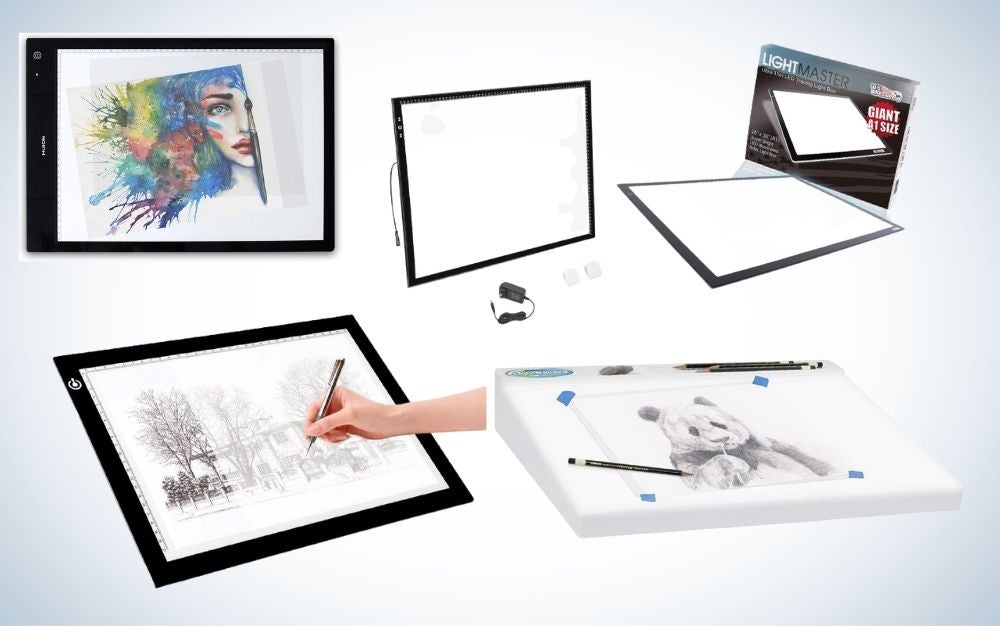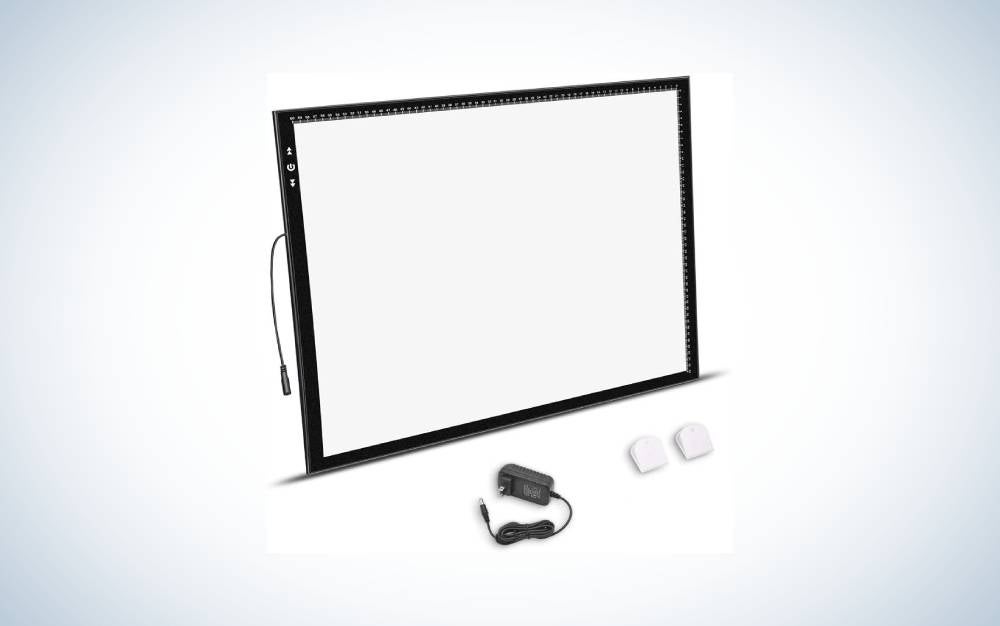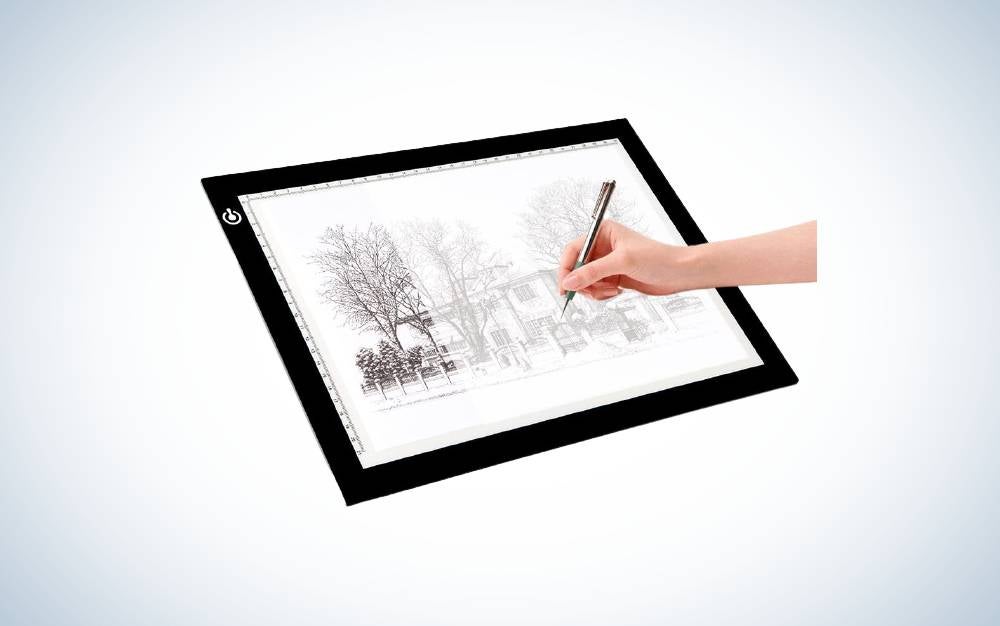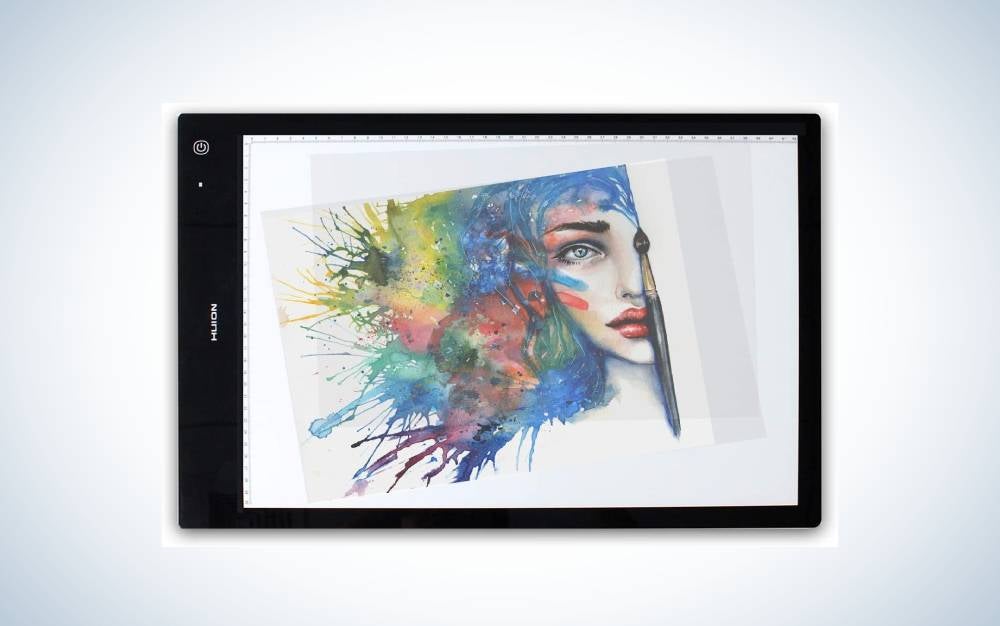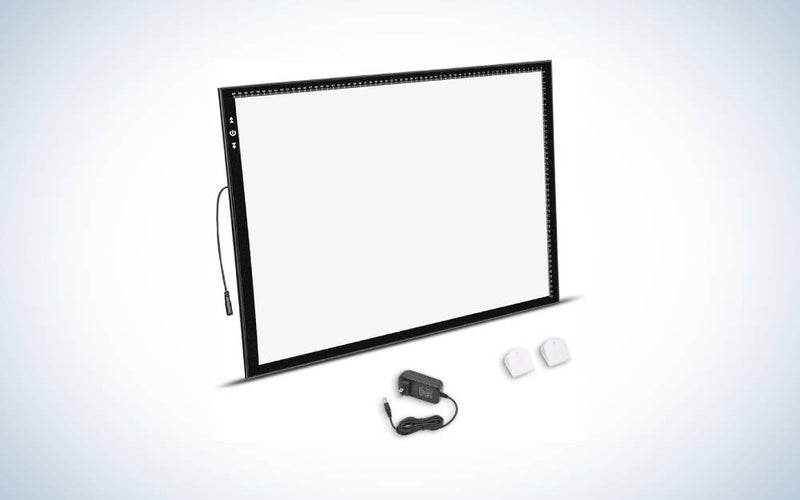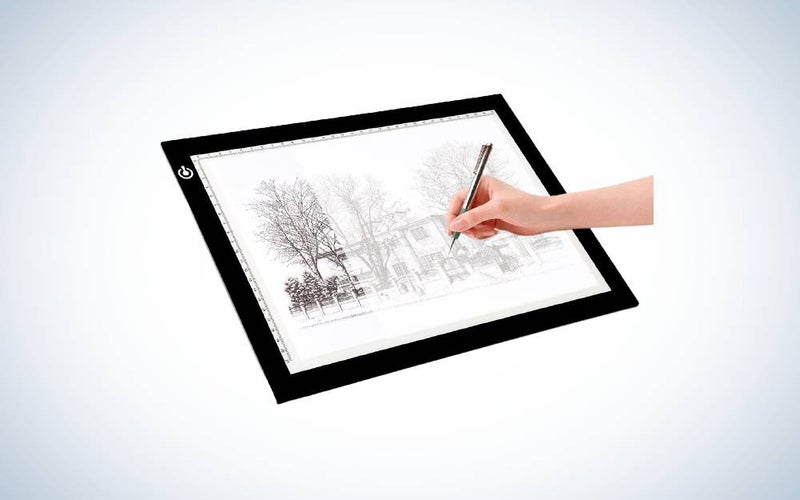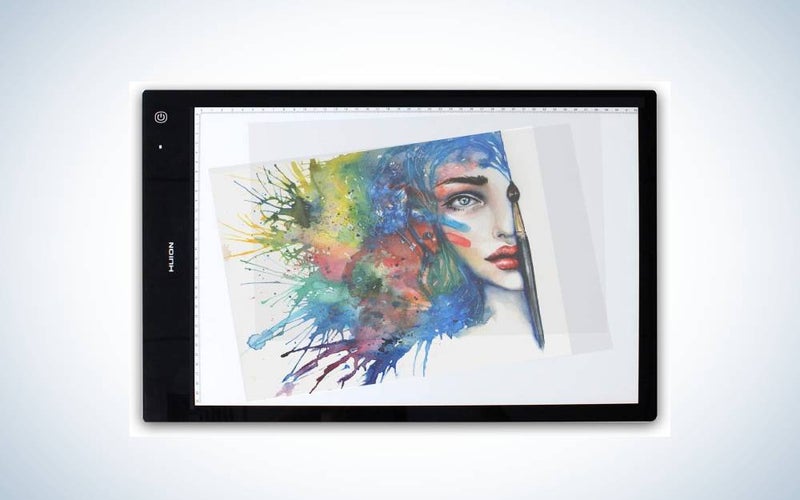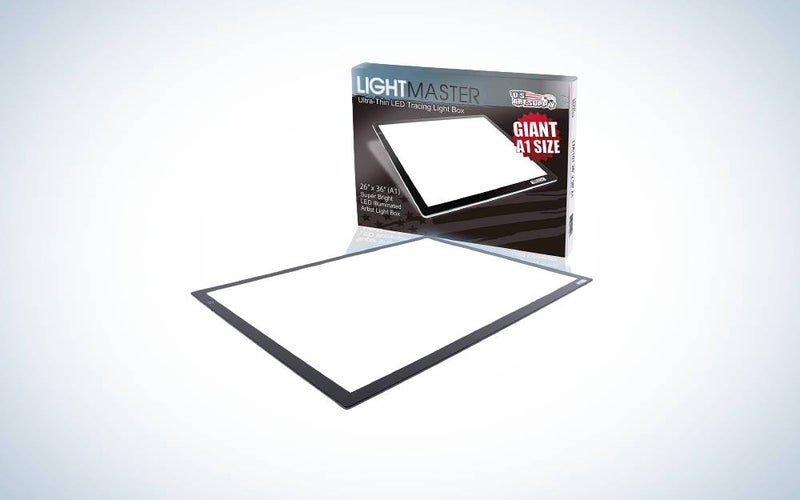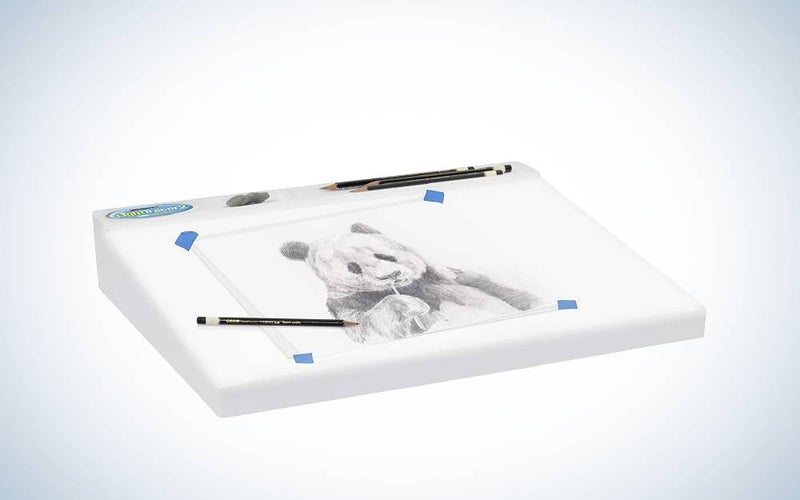We may earn revenue from the products available on this page and participate in affiliate programs. Learn more ›
A light box is a crucial tool for any artist that uses tracing as a cornerstone of their practice. The options of yesteryear often used fluorescent bulbs beneath a frosted glass cover. However, innovation is everywhere, and today’s light boxes for tracing are generally ultra slim and about the thickness of a tablet.
Light boxes come in a few general size categories. Often, one brand will feature three or four different size options. Different brands vary with how much illumination, or lux, their products provide. It’s also important to note that most light boxes on the market use a cord, rather than battery power, so cord quality and length can be an important consideration when picking out your light box. So whether you’re looking for the best light boxes for artists or the for photography, these recommendations should serve your needs.
- Best overall: HSK A2 Light Box Light Pad
- Best budget: LITENERGY Portable A4 Tracing
- Best for artists: HUION LB4 Wireless Tracing Light Box Battery Powered
- Best for quilting: US Art Supply Lightmaster Giant
- Best for slide viewing: Artograph LightTracer 2 LED Light Box
How we picked the best light boxes
With so many light boxes on the market, we used a short list of criteria to narrow down which models made the cut. We researched twenty different models from ten different brands to find the best light boxes. One element that complicated this process was sizing. Most companies that produce light boxes offer multiple different sizes for their products. Yet, not every size by every company offers the same value and functionality. In picking the these, we factored in which size paired with which features to offer the best all-around quality from a given company. Here’s how we broke it down.
- Size: Light boxes come in many sizes. However, they tend to fall into a number of general categories, which are loosely equivalent across all brands. A4 is the smallest size and will snugly fit one sheet of computer paper. A1, on the other hand, is very large and may take up most of the surface of your desk. While these distinctions are most important for preference (not everyone needs an A1), we did factor in the size of each product, along with its other features, to determine its quality. Most brands on this list are available in multiple sizes. But not every product stands out in every size the brand might offer.
- Lux: Most of us are basically familiar with the term “lumen,” which measures the output of illumination that a source provides. However, lux is a less common term. Lux measures light cast upon a surface (in this case, that surface is the image you’re tracing). Lux is an all-important factor in light box design, because high lux equals lots of light hitting the image you’ll be working with.
- Cord and battery quality: In the era of tablets, we often expect our devices to come with us around the house. Maybe we want to trace an image while we watch TV on the couch. Perhaps we want to diamond-paint at the kitchen table. Battery power is still an exception to the rule in light box design. That made battery power and cord length an important marker of quality in all our picks for the best light boxes.
- Material Quality: Especially important with the ultra-slim tablet-sized light boxes that dominate the market, material quality is everything when it comes to longevity.
The best light boxes: Reviews & Recommendations
Best overall: HSK A2 Light Box Light Pad
Why it made the cut: With a six-foot cord, 4,500 lux of illumination, and a sturdy aluminum frame with no light bleed on the sides, this option does everything right.
Specs:
- Size: A2: 25.35 x 18.5 x .3 inches
- lux Watts: 4,500 lux, 20-watt dimmer
- Cord / Battery: Cord, six feet
Pros:
- Six-foot cord means you can adapt this light box to the room
- Large and well lit
- Ruler along two sides of art board
Cons:
- Gets hot
- Ruler is metric only
What’s better in a product than all-around strong functionality and the right set of features? When I’m in the studio working on a drawing, I love it when I can find the right space for my flow. Oftentimes, that’s my desk. But other times that might be the floor, the couch, or even my bed. With its six-foot cord and A2-size large screen, the HSK Light Box has everything that most artists would want out of a light box for tracing. Its large screen size means that this pad could function like a desk if you’re using it on the couch. It yields enough space for large paper sizes, or multiple sets of source material to trace from. Rulers along two edges of the work space offer built-in precision.
With an aluminum frame lining the work space, this light box comes with good structure. However, some users say that the metal frame does get hot. This is a concern with any light source or tablet, but if you’re particularly sensitive to heat it may be worth it to look for a light box without an aluminum frame, such as our pick for the best light box overall with an angle, the Artograph LightTracer 2 LED Light Box. One thing to be wary of is that users complain that the warehouse is out of stock on replacement cords for the HSK. If you lose the power cord, it may be difficult to replace it.
Best budget: LITENERGY Portable A4 Tracing
Why it made the cut: LITENERGY had to make the list, and with a little bit of everything for a tiny price, this A4 tracing pad is a clear top dog for a value pick.
Specs:
- Size: A4: 14.2 x 10.6 x .2 inches
- Lux / Watts: 3,000–4,000 lux, 4.5-watt adjustable
- Cord / Adapter: 56-inch USB cord
Pros:
- Eyesight protection with flicker-free LEDs
- USB cord plugs into any USB source
- Adjustable brightness
- Colored frame with four color options
Cons:
- No adapter for USB
- Lux could be higher
LITENERGY is one of the best-selling makers on the market, and this mini light box synthesizes many of the brand’s best qualities into a true value product. The A4 size means that this tracing pad is good for standard computer-sized paper. If you’re looking to trace a drawing or work on relatively small-size diamond art, this could be the option for you. With bright pink and neon green frame options, this is also a flashy choice that kids will love.
LITENERGY has a strong brand reputation no matter the size. While it made our list as the best cheap light box, the brand is worth a look for more expensive A3- and A2-size light boxes. With good quality screens and frames, high lux ratings on the larger sizes, and reliable dimmers, this brand does light boxes well. However, users do sometimes note issues with the brand’s plugs. The USB plug on the A4 size doesn’t come with a cord adapter, and some users have complained that the larger models had give in the middle of the screen.
Best for artists: HUION LB4 Wireless Tracing Light Box Battery Powered
Why it made the cut: This great quality tablet-style device comes with a built-in battery, meaning you can take your studio anywhere.
Specs:
- Size: A4: 15.74 x 10.63 x .3 inches
- Lux / Watts: 1,500 lux, adjustable
- Cord / Battery: USB cord and adapter
Pros:
- Wireless: Battery charges in an hour and lasts for 3.5 hours
- USB cord with adapter plugs into any USB source
- Seamless adjustable brightness
Cons:
- Lux is low, meaning the screen is not that bright
- Expensive
Battery power gives you wings. If you want to take your tracing pad out into the world, this is the best light box for artists that will let you do it. With 3.5 hours of battery charge, this one will be there for you when you’re stenciling pine cones onto fabric in the forest, on a trip to the library archives, or just making art on the couch.
HUION is a well-known pen tablet display brand from China. It’s not surprising that this technology company’s model come with some features that set them apart from the competition, and if you’re an artist looking for a battery-powered light box, then the HUION LB4 Wireless Tracing Light Box is the best option. The battery power does make this HUION more expensive, however. This A4-size light box is priced higher than most A2-size light boxes. So for the price, you will sacrifice size. The other issue with this product is its low lux. If this one had the illumination potential of some others on this list, it may have made the list as our best overall. As it stands, however, this pad still offers decent illumination anywhere, making it a strong contender.
Best for quilting: US Art Supply Lightmaster Giant
Why it made the cut: There aren’t a lot of A1-sized options on the market. This giant-sized pick offers you a desk’s worth of illumination, but doesn’t skimp on quality.
Specs:
- Size: A1: 42 x 29 x 2.4 inches
- Lux / Watts : 11 watts, no precise lux or lumen information
- Cord / Battery: 82-inch AC power adaptor cord
Pros:
- Huge
- Adjustable brightness
- Long power cord
Cons:
- 16 pounds
- Very expensive
If you quilt full time, you trace patterns onto large swaths of fabric, or if you just work really big, you might need something a little… more. This light box from U.S. Art Supply is definitely the best light box for quilting. The size of some desks and weighing in at sixteen pounds, this light box is a studio tool that you need to plan for. It offers enough room for large quilting projects, tracing poster-size artworks, or tracing from multiple assets. And with its dimmer and flicker-free LED technology, you should be able to work with this device all day.
It is an excellent light source, capable of shining through most standard art papers and fabrics. It’s likely not bright enough to pass through cardboard or thick-grade canvas, however. That said, this model is a significant investment, but for the artist who traces or quilts as a daily part of their practice, a surface with this much space could very well be worth it.
Best for slide viewing: Artograph LightTracer 2 LED Light Box
Why It Made The Cut: With its pencil tray at the top, slanted ergonomic tracing surface, and extra bright LEDs, this one from a trusted brand is a gem.
Specs:
- Size: A1: 19 x 16 x 4 inches, 1 inch deep at bottom end
- Lux / Watts : 14,000–5,000 gradient illumination
- Cord / Battery: AC cord
Pros:
- Ergonomic slant
- Pencil holder
- Gradient illumination
- High lux
Cons:
- No dimmer
- Expensive
When looking for the best light box for slide viewing, you might want something with a different profile than what’s offered by a standard light pad. The Artograph LightTracer 2 is a light box that feels like a true art station.
The box slants from a four-inch depth at its highest dimension, to one inch at its lowest. The high-lux LEDs shine onto this slope from below. This results in a particular feature of this light box that could amount to a positive or a negative, depending on your needs. Rather than a dimmer, the device uses its slope to create a gradient of brightness. If you need more light on a particular area of your subject, you can get it by sliding your subject toward the bottom of the plane, where the surface is closer to the light. While this means that you constantly have access to a gradient of brightness without relying on electronic dimmer controls, it also means that the surface is unevenly illuminated. With so many pad-style light boxes, people complain about broken dimmer functionality with long-term use (the electronics just fail sometimes). The gradient feature may equal better longevity. It also may fit some artists’ workflow. In other cases, however, the lack of a uniform brightness could be a real hindrance.
Because of its sloped surface and natural gradient without dimmers, this pick is a superbly useful slide viewer, allowing you to adjust the illumination of your slide intuitively, without fiddling with digital controls. Because of its inherent gradient, we think the Artograph is the best slide viewer on the market.
Things to consider before buying the best light boxes
When you’re looking to upgrade your studio with a light box, there are a number of things to consider. Be sure to work through your particular needs before you make your purchase. The best light box is the one that best fits your needs as an artist.
Size
Probably the most important consideration in any light box purchase is size. They generally come in four sizes, which are loosely modeled on sizes of paper. An A4 model should fit most standard computer paper. For most users, an A4 light box is likely large enough, especially as ultra-slim models can slip under papers, fabrics, and surfaces without bending them. However, for some users, large size is important. The largest light box on our list is as large as the surface of many desks. If your light box gets a lot of use, it may be worth it to invest in a large enough pad to give you real work space.
Brightness
Do you work on thick vellum? Or perhaps you trace onto light silk? Lux is an important feature in a light box. Most pads offer dimmable LED surfaces with decent lux. Consider the surface your light box needs to shine through for your tracing needs.
Portability
Will you be tracing parchment records in the dimly lit basement of an ancient manor house? If so, you might want one that has a battery. Even if you’re not taking your light box on adventures, it can still be useful to have a device that you can carry with you from room to room and into the garden. If a battery isn’t important to you, consider cord length when the specs are available. Remember, a USB cord does mean that your light box can use a laptop or USB battery bank as a power source. So if you already carry these types of devices, a cheaper option with a USB cord instead of a battery could be just as good as a premium battery-powered pad.
FAQs
Q: What is a light box used for?
Light boxes are extremely useful tracing tools for all sorts of artists. Tattoo artists use them for tracing designs, illustrators use them to transfer static scenes from one image to the next, photographers use them to preview slides, and textile artists use them for patterns. Diamond painting is also a very popular activity that requires one.
Q: What is lux?
Lux is a measurement that defines how much light is cast onto a surface over a given meter. Ten lumens cast on one square meter becomes 10 lux. However, 10 lumens cast on 10 square meters becomes 1 lux. Where a light box is concerned, lux measures how much light will be cast upon the image that you are tracing.
Q: What’s the difference between a light box and a light pad?
It really comes down to LEDs. In older models, the box itself had to include enough space for light bulbs. These bulbs would shine underneath a (generally) frosted glass surface. Today with LED technology, a light box can be less than an inch thick. Now ultra-thin options are referred to interchangeably as either light boxes or light pads.
Q: Do I need the premium art box? Or should I buy the budget option?
With such a large price range for light boxes, it can be hard to know how much money to spend. The truth of the matter is that a light box under thirty dollars may legitimately serve you better than one that costs hundreds, while for some users, the cheaper options could prove completely useless. Most importantly, consider the size of the project you work on and the portability you require. Let the features you need dictate how much money to spend. Beyond that, always look for quality.
Final thoughts on the best light boxes
The purchase of a light box should be exciting. A good light box is a powerful tool to add to your studio. If you’re someone who values mobility, the HUION LB4 is an excellent pick. For someone who just landed a job in a cutting-edge animation house, the US Art Supply Lightmaster Giant is a major addition to a studio that will give you all the tracing space you need. For the average committed user, the HSK A2 does everything right for a decent price, while LITENERGY Portable A4 Tracing brings great value for those minding their wallets.
